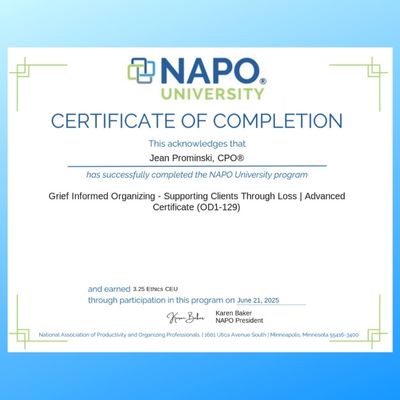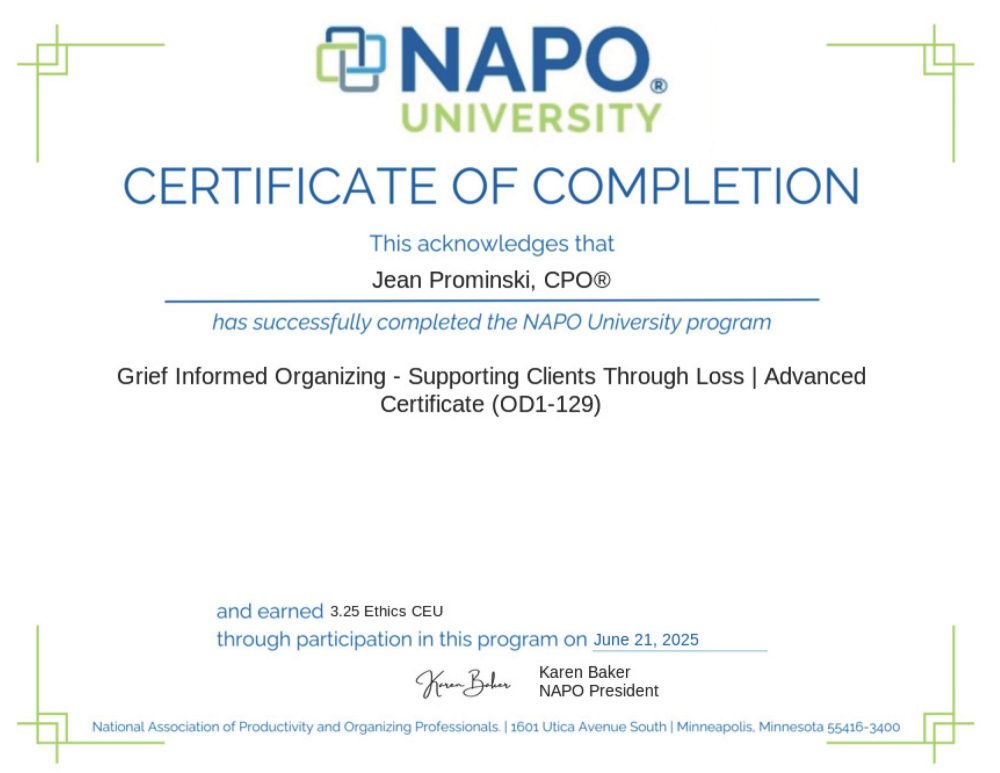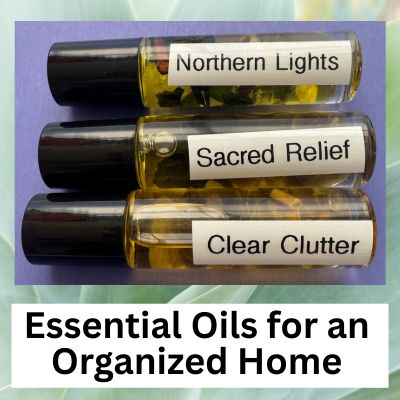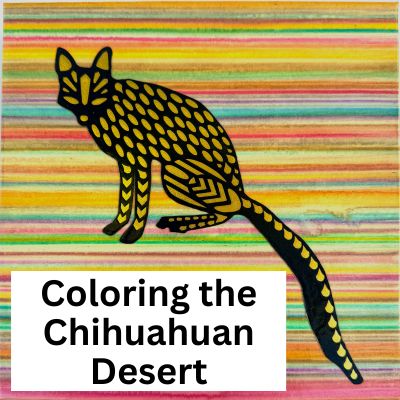Grief Informed Organizing


One of my favorite things about being a Certified Professional Organizer through the National Association of Productivity and Organizing Professionals (NAPO) is their requirement for continuing education for us to uphold our credentials. We don’t have to take classes through NAPO, but they do offer a really wonderful selection of lessons catered specifically towards organizers so that we can better help our clients. I recently took their new advanced certificate: Grief Informed Organizing- Supporting Clients Through Loss. After 10 years as a professional organizer, I’ve found that organizing is as much about emotional support as it is about sorting stuff. I’ve taken other workshops on grief before, but this one taught me new insights into how grief affects the nervous system, hormones, and even our physical surroundings. I gained a deeper understanding of how emotional pain can show up as clutter, fatigue, or disconnection in daily life. In this post, I’ll talk about some highlights from the content.
The Grief Informed Organizing certificate consisted of seven different lessons:
- Understanding Grief
- Learning The Language of Grief: The Role of a Grief Informed Organizer
- Cultural, Spiritual, and Family Considerations in Grief
- The Healing Power of Our Homes: How Our Physical Spaces Can Support Us in Grief
- Boundaries & Best Practices for Organizing Through Grief
- Ethical Considerations & Professional Referrals
- Beyond Organizing- Grief, Presence & Care
Anticipatory Grief: the emotional pain and mourning that occurs before an impending loss—most commonly in response to the expected death of a loved one, a terminal diagnosis, or major life changes like the loss of independence, identity, or home.
Cumulative Grief: the layered sorrow that builds when multiple losses occur close together or go unresolved over time. It can feel overwhelming, as each new loss reactivates previous grief. Without space to process, it often leads to emotional exhaustion or numbness.
Disenfranchised Grief: grief that isn’t openly acknowledged, socially supported, or publicly mourned. It can occur after losses that others minimize or don’t recognize as “valid,” such as the death of a pet, miscarriage, estrangement, incarceration, breaking away from an organized religion, or the loss of a home or identity. This type of grief is often experienced in silence, making it even more isolating.
Traumatic Grief: occurs when a loss is sudden, violent, or deeply shocking, making it difficult to process emotionally. It combines intense grief with symptoms of trauma, such as flashbacks, fear, or numbness. This type of grief can disrupt a person’s sense of safety and may require additional support to heal.
Reactions to Grief
Reactions to grief may include shock and denial, unpredictable emotions, numbness, flashbacks, nightmares, strained relationships, physical symptoms, difficulty concentrating, changes in appetite or sleep, anxiety, guilt, or a deep sense of emptiness. Grief affects each person differently and can show up emotionally, mentally, physically, and spiritually.
Emotional Pain = Physical Ailments = Clutter
We also learned about different ways in which emotions can cause physical symptoms. “Broken Heart Syndrome” can cause intense emotions that strain the heart. Stress hormones cause the heart to swell, blood pressure to spike, and heartbeat to race. The lungs are also very intertwined with grief. Breathing patterns can change and cause respiratory issues. Grief can also cause hormonal changes which effect cortisol levels, the body’s main stress hormone. Elevated cortisol from prolonged grief can lead to fatigue, sleep issues, weakened immunity, and increased anxiety or depression. Epinephrine (adrenaline) and norepinephrine (noradrenaline) are stress hormones that help trigger the body’s “fight-or-flight” response. Epinephrine boosts heart rate and energy, while norepinephrine sharpens focus and raises blood pressure. When these are activated too often—like during chronic stress—they can lead to anxiety, irritability, and emotional exhaustion. Grief can also lower dopamine and oxytocin levels—chemicals linked to pleasure, motivation, and connection. This drop can make it harder to feel joy, stay focused, or connect with others, deepening the sense of isolation and emotional numbness. When grief disrupts your hormones and nervous system, it can drain your energy, cloud your focus, and numb your motivation—making even simple tasks feel overwhelming. As a result, clutter can start to build up, not from laziness, but as a reflection of emotional overload. The physical environment often mirrors the inner state. Grief dysregulates the nervous system, keeping the body stuck in survival mode. This can lead to brain fog, fatigue, and emotional overwhelm—making it hard to make decisions, stay organized, or keep up with daily tasks. Clutter often accumulates as a natural byproduct of this inner chaos.
Grief Can Lower the Immune System
When the body is under emotional strain, the immune system weakens, making it harder to fight off illness. This can lead to:
- Headaches and body aches
- Nausea or digestive discomfort
- Loss of appetite and dehydration
- Insomnia and disrupted sleep patterns
These physical symptoms can make it even harder to manage everyday responsibilities, including staying organized.
Grief Mixed with Guilt
This isn’t something that was taught in the course, but it’s something I’ve learned about through other grief courses. Grief mixed with guilt can intensify both emotional and physical symptoms. When someone feels responsible for a loss—like leaving a religion, ending a relationship, or making a difficult choice—they may carry unresolved guilt that the body processes as physical distress. This can show up as headaches, fatigue, chest tightness, digestive issues, or chronic tension—essentially, the body manifesting the emotional burden when it hasn’t been fully expressed or released.
Signs Of Grief
Grief is non-linear. Things that once came easily may now be a challenge. Grief can be disorienting and exhausting. Emotional overwhelm, creating a “dumping ground”, not knowing where to start, physical fatigue, difficulty finishing tasks, difficulty focusing, isolation, lack of support, and a loss of interest in activities are all subtle ways grief can show up. It’s like a pin-ball machine, and as a grief-informed organizer, I am trained to meet clients where they are.
Grief touches every part of a person’s life—including their home. As a Certified Professional Organizer, I’m committed to meeting clients with compassion, not just strategy. Whether someone is grieving the loss of a loved one, a former identity, or simply the life they thought they’d have, our spaces often tell the story. When we approach organizing through a grief-informed lens, we create space not just for our belongings—but for healing, clarity, and care.
If you’re curious about reading more about decluttering and grief, here are a few other posts I’ve written about it:
Decluttering and Organizing After the Loss of a Loved One
Decluttering and Organizing After the Loss of a Pet

Posted By Jean Prominski, Certified Professional Organizer
- Follow me on Instagram @carlsbadsparkle
- Join my Facebook Group, Declutter and Organize with SparkleHomeOrganizing.
- Ready to book a consultation? Complete this form.
- For artwork to energize your home, order through jeanprominski.com.




